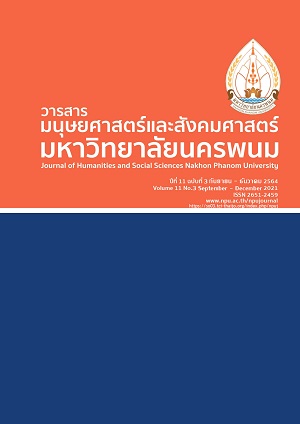Role of Rojana : the Lakhon Nok in the Royal Court Style Heroine in Sangthong
Main Article Content
Abstract
This research article has two objectives, namely to study the background and characters of the Rojana’s role in Sangthong and to study five emotions namely love, sorrow, irony, ridicule and anger, of dance postures of Rojana in Lakhon nok in the royal court style performed in the episode “Leuak Khu – Ha Pla” of the story Sangthong. The methods applied in this research are qualitative methods, interview with experts and analysis of data from playbills, documents and related research from various data resources and the practice of dancing. Then, the data have been compiled and presented in a descriptive analysis. The result of the study showed that Rojana significantly had many characters which affected the process of the story. The Lakhon nok in the royal court style Santhong popularly chose the episode “Leuk khu-Ha Pla” to perform because it contained the conflicts to bring about the chaos and to let the audience understand that cause of the next episode. There are dances to show off the skills of the main character, fun unique ways of dances, and a lot of performers involved in this episode. These compositions made the performance grand, joyful and fun. The dance postures of Rojana in this Lakhon nok in the royal court style had been found that they need to clearly convey the emotions through the postures and face expressions according to the characters.
Article Details
References
Buddha Loetla Nanhalai. Phrabat Somdet Phar. (1987). Botlakhō̜nnō̜k writiings by the king (Rama II).
(8 th Ed.). Bangkok: Prachāchon Čhamkat. [in Thai]
Buddha Loetla Nanhalai. Phrabat Somdet Phar, (2002). Botlakhō̜nnō̜k writiings by the king (Rama II). Bangkok: Sophonkānphi. [in Thai]
Chansuwan S, Assoc. Prof. (September 2018). Sinlapinhǣngchāt Sākhāsinlapakānsadǣng (nātsin) 2005. Phūchīaochāndānnātsinthai. Bunditpatanasilpa Institute. [in Thai]
Huamưanglat K. (September 2018). Nātsinlapinnātsinlapinʻāwusō. Office of the Music And Drama, The Fine Arts Department. [in Thai]
Limsakun P. (2006). Ramdīaomāttrathān Tūanāng (2 th Ed.). Bangkok: Bō̜risatʻǣkthīp Phari Čhamkat. [in Thai]
Malai (nāmfǣng). (1993). Nāngnaiwannakhadī.: Pimthīborwornsānkānphi Čhamkat. [in Thai]
Paul Ekman. (2563). ʻārom phư̄nthān thī song phon tō̜ phrưttikam manut. Retieved from https://blog.ooca.co/2020/07/09/7- อารมณ์พื้นฐานที่ส่งผลต/
Raksamanee K. (1991). kān wikhro̜ wannakhadī Thai tām thritsadī wannakhadī sansakrit. (2 th Ed.).
Bangkok : khrōngkān tamrā phāsā - č้้hārưk Faculty of Achaeology Silpakon University . [in Thai]
Suponchit S. (2018). The dance process costumes of sangtong in play performed by all male in sangtong story. Master of fine arts program in thai dama Graduate school Bunditpatanasilpa. [in Thai]
The Fine Arts Department. (1954). Botlakhō̜nnō̜k Rư̄angsangthong Tō̜n Lư̄akkhūlæhāplā. Phranakhō̜n: Rōngphimphračhan. [in Thai]
Thongkhamsuk P. (2018). Rātchabanthittayasaphā Sākhānātkamthai Nakwichākānlakhō̜n lædontrīchamnankān. Office of the Music And Drama, The Fine Arts Department. [in Thai]
Wirunrak S. (2004). wiwatthanākān nāttaya sin Thai nai krung Rattanakōsin Phō̜.Sō̜. sō̜ngphansāmrō̜iyīsiphā - sō̜ngphansīrō̜ičhetsipčhet. (2 th Ed.). Bangkok : rōngphimhǣng Čhulālongkō̜nmahāwitthayālai. [in Thai]


